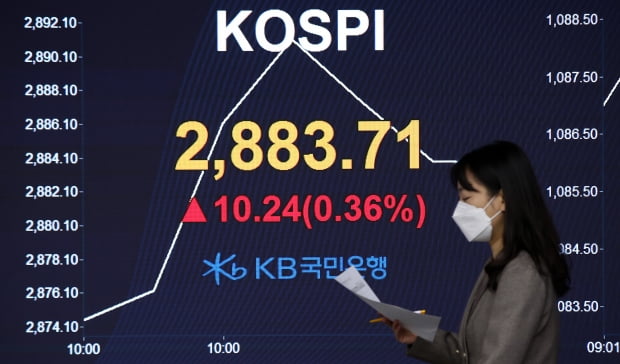
On the 4th, the first trading day of the stock market in 2021, the course index rose 10.24 points from the previous day to 2883.71, breaking a new record high during the intraday. /Photo = News 1
The domestic stock market, which broke through the ceiling last year and ended at an all-time high, is expected to continue rising this year. It is because expectations for earnings improvement from overcoming the novel coronavirus infection (Corona 19) and the launch effect of the Joe Biden administration are expected to stimulate investment sentiment.
In January, the securities industry advises to focus on KOSDAQ rather than KOSPI and small-caps rather than large-caps. The reason is that investors tend to focus on small-cap stocks that are expected to grow rather than large-cap stocks that have lost the year-end dividend effect.
According to Daishin Securities on the 4th, the average monthly return of the KOSDAQ for the past 20 years from 2001 was 5.6%, far higher than the KOSPI (1.4%). Thirteen times, the KOSDAQ yield surpassed the KOSPI. In terms of win rate, it is 65%.
Kim Ji-yoon, a researcher at Daishin Securities, said, “The’January effect’, which means that the stock price in January has risen significantly compared to other months, was not evident in the KOSPI.” “The average KOSPI return in January every year for the last 20 years was 1.4%, rather than April. And the average return (3.5%) in November was higher.”
During the same period, KOSDAQ’s average yield in January was 5.6%, showing a solid level. Researcher Kim explained that the KOSDAQ showed a strong trend from January to May and then declined from June.
Even within the KOSPI, small caps showed higher returns in January than large caps. Researcher Kim explained, “At the end of the year, large-cap stocks are advantageous due to the effect of dividends, but in January, KOSPI small-caps and KOSDAQ were strong.”

Photo = Yonhap News
Yang Hae-jeong, a researcher at DS Investment & Securities, predicts that the KOSDAQ index will open the era of 1,000 points in 20 years as small and mid-cap stocks continue to rise.
Researcher Yang emphasized that “the January effect this year is more likely to appear more clearly than at other times,” and emphasized that “they are equipped with low interest rates, strong won, economic recovery, and liquidity that allow small and mid-cap stocks to show strong strength.”
In the securities industry, KOSDAQ and small-cap stocks are advantageous in terms of yield, but the overall trend of the domestic stock market is expected to maintain an uptrend. It is expected that the bullish rally could continue even if the bull market is not expected at the end of the year.
Lee Eun-taek, a researcher at KB Securities, said, “The growth momentum of the domestic stock market may be less than at the end of the year,” and “The fourth quarter results and expectations of the Biden government will support the stock market rally at the beginning of the year.”
Kyobo Securities Research Center Director Kim Hyung-ryul also said, “As the stock market marches high at the end of the year, there are voices of abnormal speculation overheating, but reflecting the future economic conditions, it is evaluated as normal.” “You should not make the mistake of over-interpreting it as an entry.”
Some advised that a strategy of’recession of the daily report’ is necessary as it could lead to a stronger-than-expected adjustment phase.
Samsung Securities researcher Kim Yong-gu said, “The market showed a rally at the end of last year, but the economic situation is difficult and political uncertainties such as the US Senate vote in Georgia are still there.” .
However, “As a whole this year, the KOSPI can rise to a maximum of 3300 depending on the global economic recovery and semiconductor-led export improvement,” he said. said.
Yoon Jin-woo, reporter at Hankyung.com [email protected]
